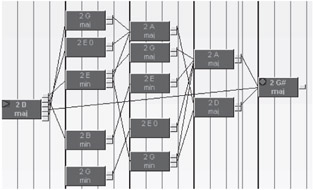Pattern Length and Chord Rhythm
Now let's discuss chord rhythm, pattern length, and how DirectMusic chooses which pattern is appropriate to play a given set of chords. So far, every Style that we have dealt with had only one pattern, but it is often better to have several patterns to add variety. One chord change every measure with the same musical motifs repeatedly can get tiresome. You can compose separate patterns for each level of chord activity. By default, DirectMusic picks the longest pattern that fits the chord rhythm in the Segment. This default behavior only holds true if you have a Groove Track with a groove level specified. Adding a Groove Track will not hurt your content if you do not plan to use grooves. Just put any number in the first measure. For an example, look at the bookmark AdvancedTechniques. The Style has two patterns. One is one measure long, and the other is four. What really matters is the chord rhythm. Go to the properties page of the pattern 4Bar. At the bottom is the chord rhythm section. You can click the Set button to change the setting. After adjusting the setting, you can then click the boxes to put an x in every place where there should be a chord change. The four-measure pattern is chosen every time that there is no chord change for four bars because the pattern follows only one chord for four measures. If you put an x at the beginning of every measure, the 4Bar pattern always plays because it is the longest pattern with the correct chord rhythm in all cases.
There are two variations in 4Bar. One variation is a single chord, but the other variation moves every two beats. Patterns with only one chord change are a good way to take some liberty with the chords in your patterns. You can have different chord rhythms in every variation. Faster, syncopated, and less regular chord rhythms are sometimes better written out exactly without being subject to Chord Track's control. Chord rhythm variability is very easy with this pattern, since there is only one part and there is no need to do variation locking to keep the harmonies together.
You can still build inherent chord progressions into different variations if you have multiple parts. All you need to do is take advantage of locking variations. To get this setup to work, you need to make sure that the ChordMap can play for a longer period of time with only one chord. In this example's ChordMap (shown in Figure 6-10), you will notice a connection that has been drawn from the first signpost directly to the second target signpost. If there were no connecting chords, this would not be necessary, but since there are connection chords, DirectMusic will only take paths that are specified when moving between these two signposts.

Figure 6-10: Randomly bypassing connecting chords.
EAN: 2147483647
Pages: 170